The AMD Threadripper 2990WX 32-Core and 2950X 16-Core Review
by Dr. Ian Cutress on August 13, 2018 9:00 AM ESTHEDT Benchmarks: Rendering Tests
Rendering is often a key target for processor workloads, lending itself to a professional environment. It comes in different formats as well, from 3D rendering through rasterization, such as games, or by ray tracing, and invokes the ability of the software to manage meshes, textures, collisions, aliasing, physics (in animations), and discarding unnecessary work. Most renderers offer CPU code paths, while a few use GPUs and select environments use FPGAs or dedicated ASICs. For big studios however, CPUs are still the hardware of choice.
Corona 1.3: Performance Render
An advanced performance based renderer for software such as 3ds Max and Cinema 4D, the Corona benchmark renders a generated scene as a standard under its 1.3 software version. Normally the GUI implementation of the benchmark shows the scene being built, and allows the user to upload the result as a ‘time to complete’.
We got in contact with the developer who gave us a command line version of the benchmark that does a direct output of results. Rather than reporting time, we report the average number of rays per second across six runs, as the performance scaling of a result per unit time is typically visually easier to understand.
The Corona benchmark website can be found at https://corona-renderer.com/benchmark
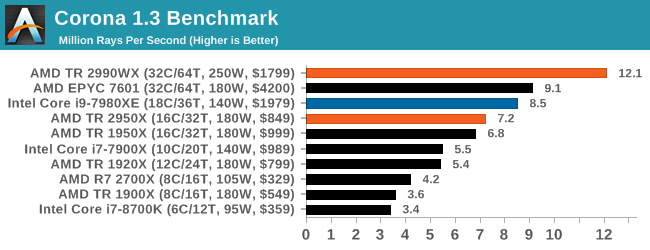
So this is where AMD broke our graphing engine. Because we report Corona in rays per second, having 12 million of them puts eight digits into our engine, which it then tries to interpret as a scientific number (1.2 x 10^7), which it can’t process in a graph. We had to convert this graph into millions of rays per second to get it to work.
The 2990WX hits out in front with 32 cores, with its higher frequency being the main reason it is so far ahead of the EPYC processor. The EPYC and Core i9 are close together, however the TR2950X at half the cost comes reasonably close.
Blender 2.79b: 3D Creation Suite
A high profile rendering tool, Blender is open-source allowing for massive amounts of configurability, and is used by a number of high-profile animation studios worldwide. The organization recently released a Blender benchmark package, a couple of weeks after we had narrowed our Blender test for our new suite, however their test can take over an hour. For our results, we run one of the sub-tests in that suite through the command line - a standard ‘bmw27’ scene in CPU only mode, and measure the time to complete the render.
Blender can be downloaded at https://www.blender.org/download/
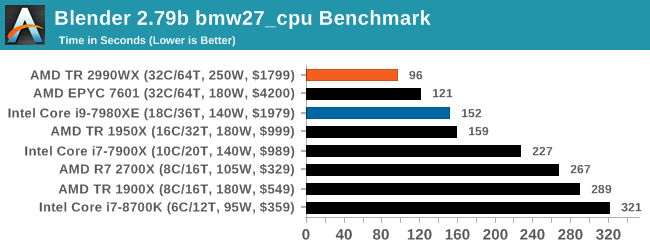
The additional cores on the 2990WX puts it out ahead of the EPYC and Core i9, with the 2990WX having an extra 58% throughput over the Core i9. That is very substantial indeed.
LuxMark v3.1: LuxRender via Different Code Paths
As stated at the top, there are many different ways to process rendering data: CPU, GPU, Accelerator, and others. On top of that, there are many frameworks and APIs in which to program, depending on how the software will be used. LuxMark, a benchmark developed using the LuxRender engine, offers several different scenes and APIs.

Taken from the Linux Version of LuxMark
In our test, we run the simple ‘Ball’ scene on both the C++ and OpenCL code paths, but in CPU mode. This scene starts with a rough render and slowly improves the quality over two minutes, giving a final result in what is essentially an average ‘kilorays per second’.
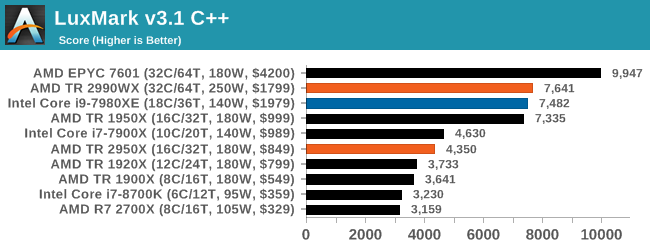
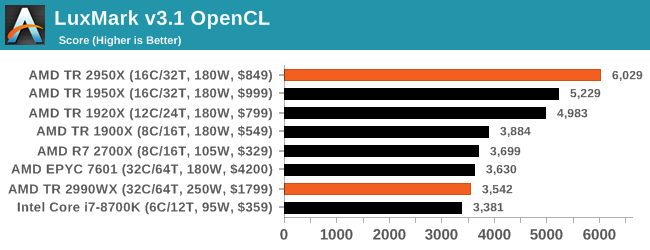
Intel’s Skylake-X processors seem to fail our OpenCL test for some reason, but in the C++ test the extra memory controllers on EPYC sets it ahead of both TR2 and Core i9. The 2990WX and Core i9 are almost equal here.
POV-Ray 3.7.1: Ray Tracing
The Persistence of Vision ray tracing engine is another well-known benchmarking tool, which was in a state of relative hibernation until AMD released its Zen processors, to which suddenly both Intel and AMD were submitting code to the main branch of the open source project. For our test, we use the built-in benchmark for all-cores, called from the command line.
POV-Ray can be downloaded from http://www.povray.org/
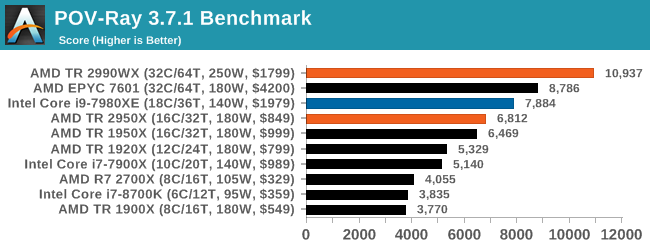
This test is another that loves the cores and frequency of the 2990WX, finishing the benchmark in almost 20 seconds. It might be time for a bigger built-in benchmark.


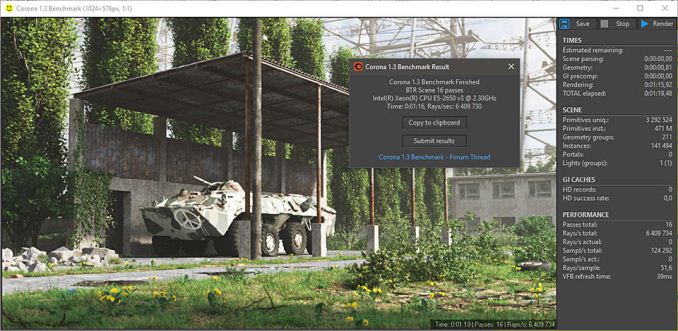








171 Comments
View All Comments
NevynPA - Tuesday, August 14, 2018 - link
Will there be results for WX chips in 'Game Mode' at various core/thread counts (6/12,8/16,12/24)?jospoortvliet - Saturday, August 18, 2018 - link
It has no game mode. Don't bother buying it for games...jts888 - Tuesday, August 14, 2018 - link
What is the methodology used for the core/uncore power breakdown? Where was a physical measurement or software reading taken, and what were the loads used?Furthermore, Zen uses single-ended signaling for IF links with alleged even further reduced power draw when in transient no-send states, so there should be at least two clearly explained tests done (i.e., both high and low inter-thread/core/sock bandwidth, with NUMA allocations detailed) before interconnect power breakdowns can be credibly presented as flat metrics of the architectures investigated.
Although this review is still a work in progress, it needs some substantial improvements in clarity given the strength of the claims made and conclusions drawn.
ktmrc8 - Thursday, August 16, 2018 - link
Let me add my voice to those asking for further elaboration on this point. I think it's very interesting, but I would like enough detail so that I could possibly replicate your data. In particular, I the charts showing power consumption decreasing as number of loaded threads increase counter-intuitive (at least for me!). Thanks.Sahrin - Tuesday, August 14, 2018 - link
The link power is a problem, but I get the feeling that nowhere near the power optimization went into IF as went into the cores.notfeelingit - Tuesday, August 14, 2018 - link
What's up with the 2950X crazy low score for the PCMark10 Startup Test? Is that repeatable?crotach - Tuesday, August 14, 2018 - link
So, 2700X looks like a clear winner here?GreenReaper - Wednesday, August 15, 2018 - link
For the average consumer, yes. It's a sweet spot. Heck, most would do fine with an APU. You don't expect a truck to win a race. Small engines tend to be more efficient; they're just limited in raw power.witeko - Tuesday, August 14, 2018 - link
hi, can we have some tests regarding data processing (spark, dask), machine learning (lightGBM/xgboost training), deep learning (i know there are GPUs) just to get a feeling (there are pre-made benchmarks for tensorflow) ? And also some reviews point to win10 vs linux differences for example in the zip test.farmergann - Tuesday, August 14, 2018 - link
Really should have included the Epyc 7401p as it's a serious contender in this price range (only $1,000).